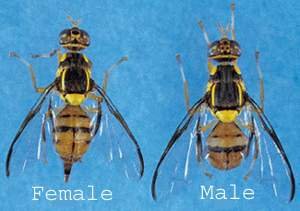Positive news, local farmers:
It’s looking like that nasty oriental fruit fly – a pesky harbinger of agricultural doom with the ability to infest more than 230 host plants from peaches to plums to peppers to cucumber – has been kept at bay.
So far.
Since the California Secretary of Agriculture issued a proclamation July 27 declaring an emergency that authorized an eradication process, the Santa Clara County Agricultural Commissioner’s office reports no additional fruit flies have been detected as of Wednesday.
Four flies were originally found in late July near the area of Tennant Avenue and Monterey Road in Morgan Hill, triggering an “infestation” determination along with heavy trapping and bait station applications. This process differs from a quarantine, wherein local crops cannot be moved.
Now, the waiting game continues.
If officials find two additional fruit flies in the same area (as the initial discovery) before the current life cycle of the insect comes to an end in mid-September, a quarantine will be triggered.
And that’s not good.
Ian Teresi of George Chiala Farms previously explained that a quarantine is the “double whammy” of destruction – hitting farmers on all sides by rotting their crops, placing a hold on shipment and costing each grower thousands of dollars for the spray treatment.
“These flies are pretty ferocious and reproduce pretty fast,” Teresi said. “It’s devastating any way you look at it.”
With a four-week spray treatment costing each farmer $160 per acre, growers like Teresi – who has about 60 acres of bell pepper crops – would be looking at a $9,000 bill. That’s in addition to money lost from rotted crops.
However, Executive Director Jennifer Scheer with the Santa Clara County Farm Bureau believes at this point, “the odds are pretty good that we will be able to reach the end of the life cycle before finding any more flies…the bait stations are supposed to be pretty effective.”
Given the devastating financial impacts that the fruit fly is capable of triggering, Scheer added that growers are “still definitely crossing their fingers.”
The tiny flies – which are about the size of a pinhead and native to Southern Asia – burrow inside fruit, lay eggs and populate. If not eradicated, they threaten a multimillion dollar industry. The last county infestation in Milpitas caused major concern in 2010, and was fully eradicated in July 2011, according to the county.
Infestations have occurred in California over the last 30 years and have been successfully wiped out before any critical damage, according to County Agriculture Commissioner Kevin O’Day. The fruit fly is typically found in urban areas, he said, because they “hitchhike” on fruit that is from an infested area such as Hawaii or the Philippines.
Scheer said the next bait station application, or treatment for the fruit fly in Morgan Hill will take place August 13.
Treatment entails a bait station laden with a silver dollar-sized “goopy” substance of female insect pheromones and pesticides that attracts the male fruit fly. That substance is placed high in the air on trees along streets in the area and telephone polls.
Officials have also set up another 50 traps every square mile in the infested area, Scheer reminded.
With such a high density of traps and no more flies discovered since the initial discovery in late July, “we’re certainly hopeful,” said Scheer. “We’re definitely crossing our fingers that we can make it to mid September.”












